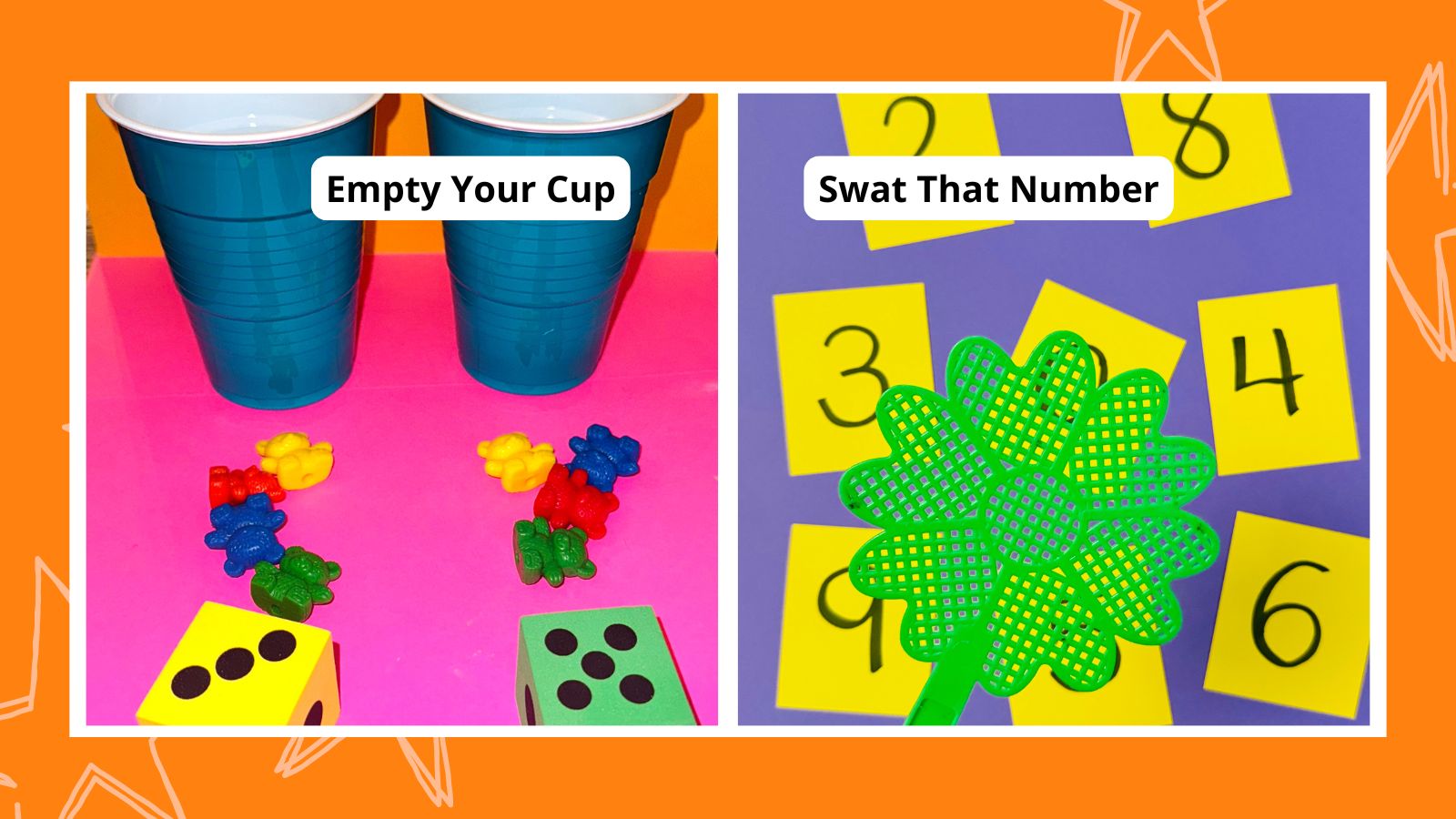Young kids learn by doing, especially preschoolers! They are active, hands-on, and excited about learning. Here’s a collection of preschool math games and activities across many early math areas that tap into that action-oriented enthusiasm and their need to get hands-on. There is a lot of emphasis on the basics of early math learning in these preschool math games, especially patterns, numbers, colors, shapes, and counting. Everything else with math builds on these. So, have fun doing and learning together with these math games for preschool students.
Preschool Math Games
1. Pipe Cleaner Counters
Students will love this engaging colorful activity that helps them practice basic counting and one-to-one correspondence. Provide pipe cleaners and pony beads (these have wide holes). Have students use 10 pipe cleaners and put one bead on the first, two beads on the second, and continuing to 10 beads on the 10th pipe cleaner. Count these out loud together as kids touch the beads on their Pipe Cleaner Counters.
2. Digging for Numbers
Provide a plastic tub of sand with a pre-determined number of playing cards “buried” in the sand. Also have a sheet of paper with numbers matching the cards. A student will dig for and find a card, then place it next to the matching number on the sheet. Of course students can use their hands to dig, but plastic shovels, plastic spoons, or tongs might add to the fun.
3. Keep It Up
So simple but so fun! Who doesn’t love to play with balloons? Students will need a balloon and a die. Students roll the die and then bounce their balloon that number of times without letting it touch the ground.
4. Roll and Build
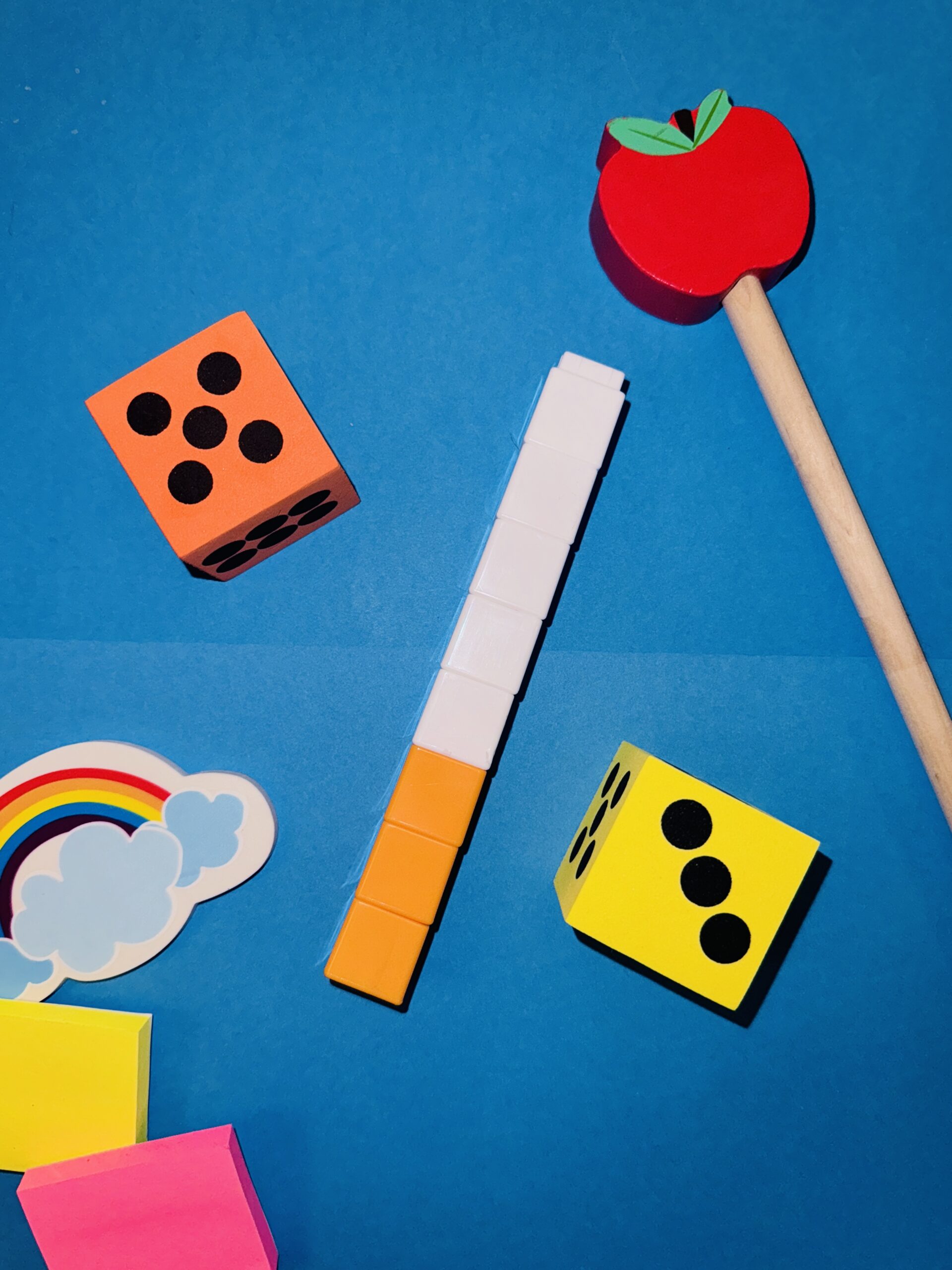
Getting hands-on with preschool math games and counting with cubes is a great way to get a “feel” for math. Give students a pair of dice and blocks, LEGO bricks, or Unifix Cubes. Students roll one die and build a tower with that number of blocks or cubes. They then roll the second die and add that number to the tower. Now count how many cubes or bricks in the tower. Compare towers. Ask questions that have students thinking and counting like, Which is tallest? How many cubes is it? Which is shortest? How many cubes in that one? Take towers apart and begin again.
5. Build a Bug
Kids love bugs, and with this activity, they get to make one. Cut out pieces of paper that create parts of two simple, identical bugs: 1 head, 2 antennae, 2 eyes, a body, 6 legs, a tail. Put all the pieces in the center. Give students a die. Students will play in pairs, rolling the die and taking that number of bug body parts and assembling them together. Keep rolling until the pair builds a complete bug.
6. Making Shapes With Sticks
This will take a bit of simple prep, but it will serve as a set of shapes that will last! Provide students with markers, wood craft sticks, and glue. Give directions to create shapes, like, “color three sticks green and put them together to make a triangle, color four sticks red for a square, color five sticks blue for a pentagon,” and so on. Students can follow a prepared mat with the colored shapes or just make the shapes with sticks without the guide mat. Try making one a day at the beginning, and then students can work independently.
7. Swat That Number
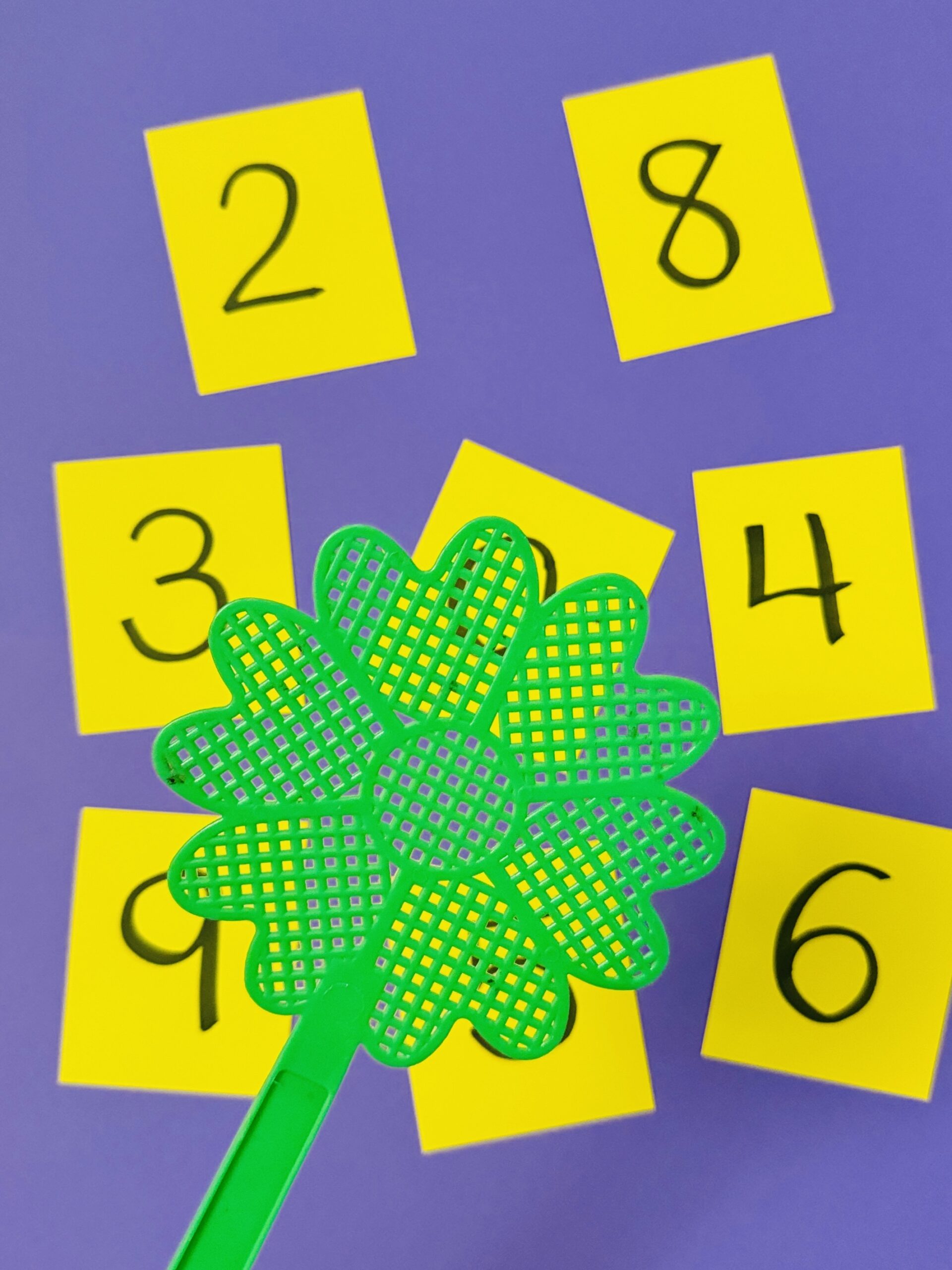
Most kids love to run around and hit things. You don’t get much chance to do that as a preschooler, but in this game you do! Write numbers 1 through 10 on the board or on cards that you place around the classroom. Give a student a fly swatter. Call out a number and the student must run to the correct number and swat that number. Everyone then says the number aloud. Pass the fly swatter on to the next person and continue until everyone gets a turn.
8. Time To Hibernate
This activity taps into imaginative play … and bears! Use six dark-colored plastic bowls as bear caves. Cut out a “cave opening” on the side of the bowls, turn the bowl/caves upside down, and put a number sticker from 1 to 6 on each cave. Provide counting bears and a die. Students will roll the die, count that many bears, and put them in the corresponding numbered cave. If that cave is already full, roll again.
9. Measuring Our Bears
Measuring with cubes is a good beginning for standardized measuring. Have students bring in a stuffed animal bear from home. In groups, have the students put the bears in order of height from shortest to tallest. Measure each bear using connecting blocks. Ask questions like: How tall was the shortest bear? The tallest? How many bears were the same height? Try this with different stuffed animals another day.
10. Park Your Vehicle
Provide some matchbox toy cars or similar. Tape a number on the roof of each vehicle. Put out a large piece of cardboard where you have drawn and numbered “parking spaces.” Kids can have some driving fun as they “park” their numbered small vehicles in their corresponding numbered parking spaces.
11. Domino Match-Up
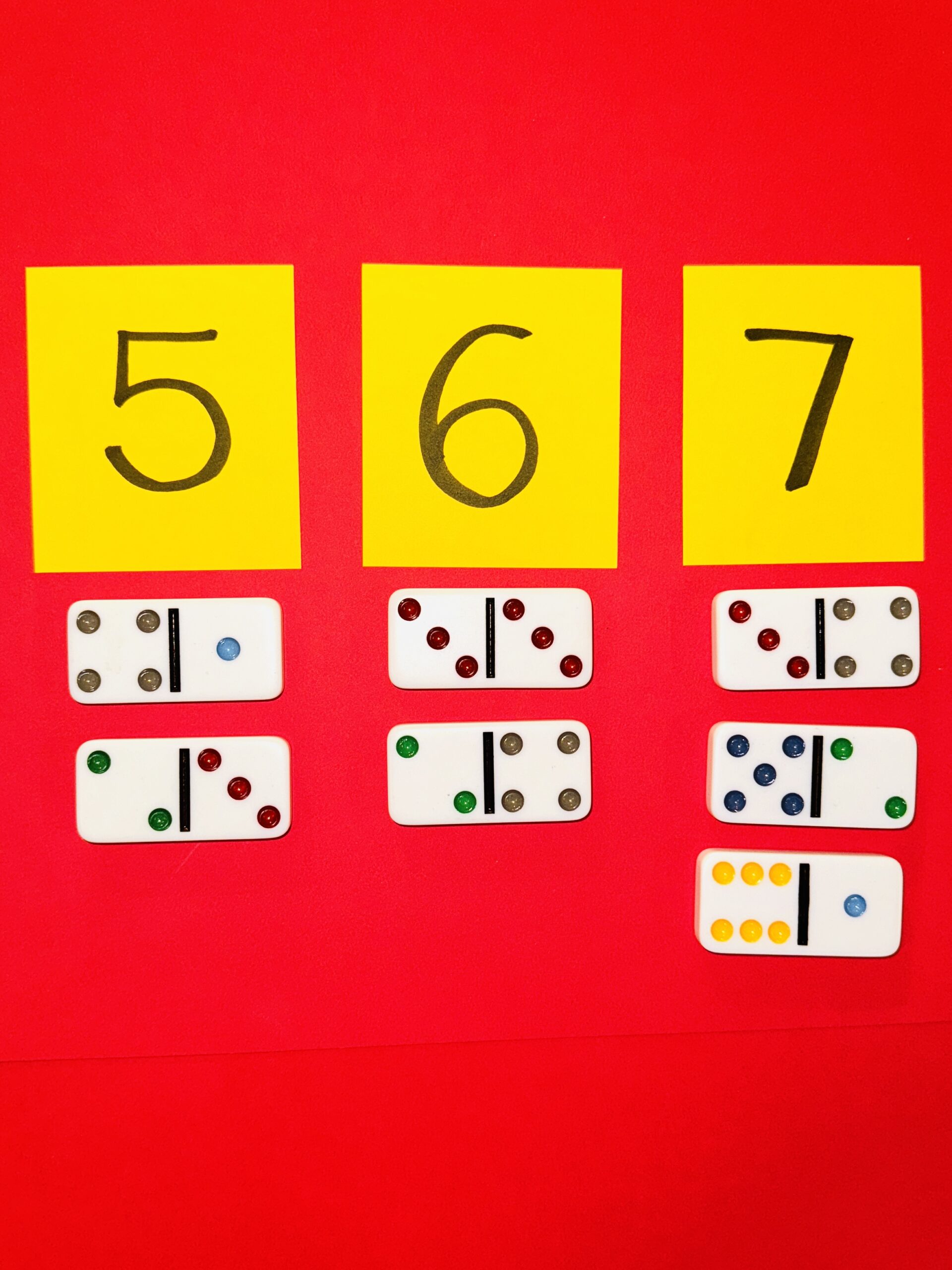
Matching countable sets with a number is a good early math skill. Here’s one way to do it. Students will use dominoes to match the values of numbered cards laid out on the floor or table. There will be several different dominoes with different combinations that will match up with each number card. For example, a number card with 6 can be matched with dominoes that have 4/2, 3/3, or 5/1.
12. Ice Tray Mirror
Patterns are the foundation of a lot of mathematics, and kids begin to notice them early on. Make an arrangement/pattern of colored circles on a prepared guide sheet. Provide students with the same color cotton balls or pom-poms. Students will use their finger, or tongs or tweezers for even more fun, to mirror the arrangement or pattern set for them by placing them in an empty ice cube tray.
13. Animal Race to 10
Pair up students and give them an un-numbered 10-space grid. Also have them each pick a small plastic animal from a set you can easily find at the dollar store. Players roll a die and move their animal that many spaces on the grid. BUT to get to the 10th and last space, they must roll the exact number.
14. Hungry Monsters
This activity has kids sorting and then building. First, create the “monsters” by gathering four or five lunch-size paper bags. Use card stock in colors that will match the colors of the blocks, LEGO bricks, or cubes. Make “monster” faces with googly eyes, markers, pencils, and other craft materials. Attach the monster face onto the paper bags, then cut out a mouth of a size the blocks can fit through.
Now the kids will feed the monsters blocks by matching the block color to the monster face color. Once all the blocks have been fed to the monsters, the students will empty the “monster bag,” count the blocks, and build something of their choice with that color block.
15. City Skyline
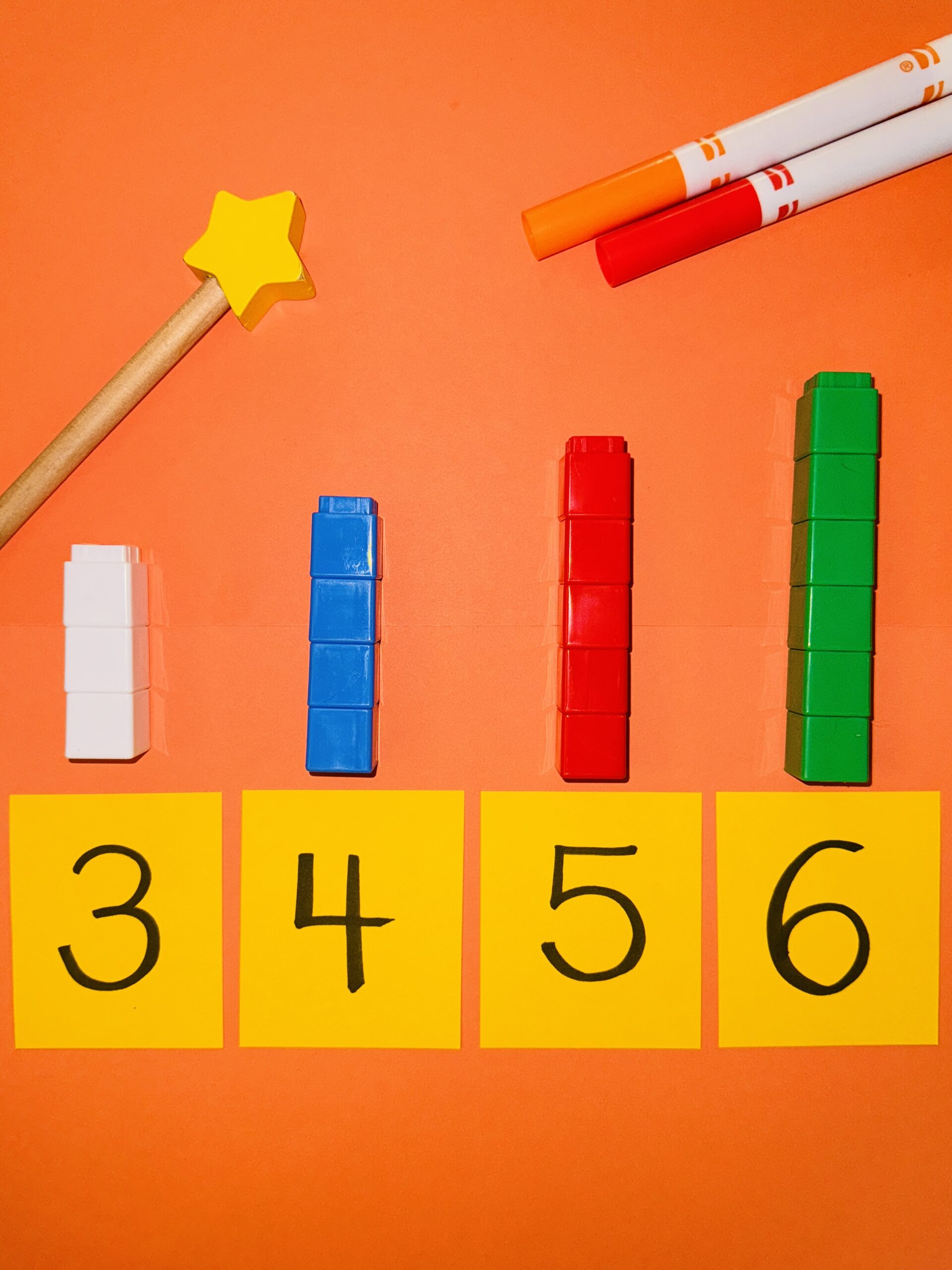
Provide students with a set of cards with single-digit numbers on them and a set of building blocks. The students will lay out the cards in a row on the table and for each number make a tower using that corresponding number of blocks right next to the card. When introducing the activity, start with four or five cards, then after some experience, add more cards with even higher numbers.
16. Tube Tower Drop
Gather several paper towel and toilet tissue tubes. Stand them upright and write a number on each one. Students will drop small objects—counting bears, blocks, etc.—into the tubes according to the number on the tube. When finished, have a partner help check by counting together.
17. Musical Dot Stop
This activity focuses on comparisons using the math vocabulary words “more” and “less.” On paper plates, stamp or draw colored circles using two different colors. The number of circles should be easy for your students to count. Every student gets a paper plate. Then start the music. Students begin to walk or bop around the room until the teacher stops the music. Then students find someone nearby to pair up with. They compare their paper plates, counting dots and comparing which one has more and which one has less. The teacher asks each pair to verbalize what they found out, and then the music and march starts again.
18. Uno Number Match-Up
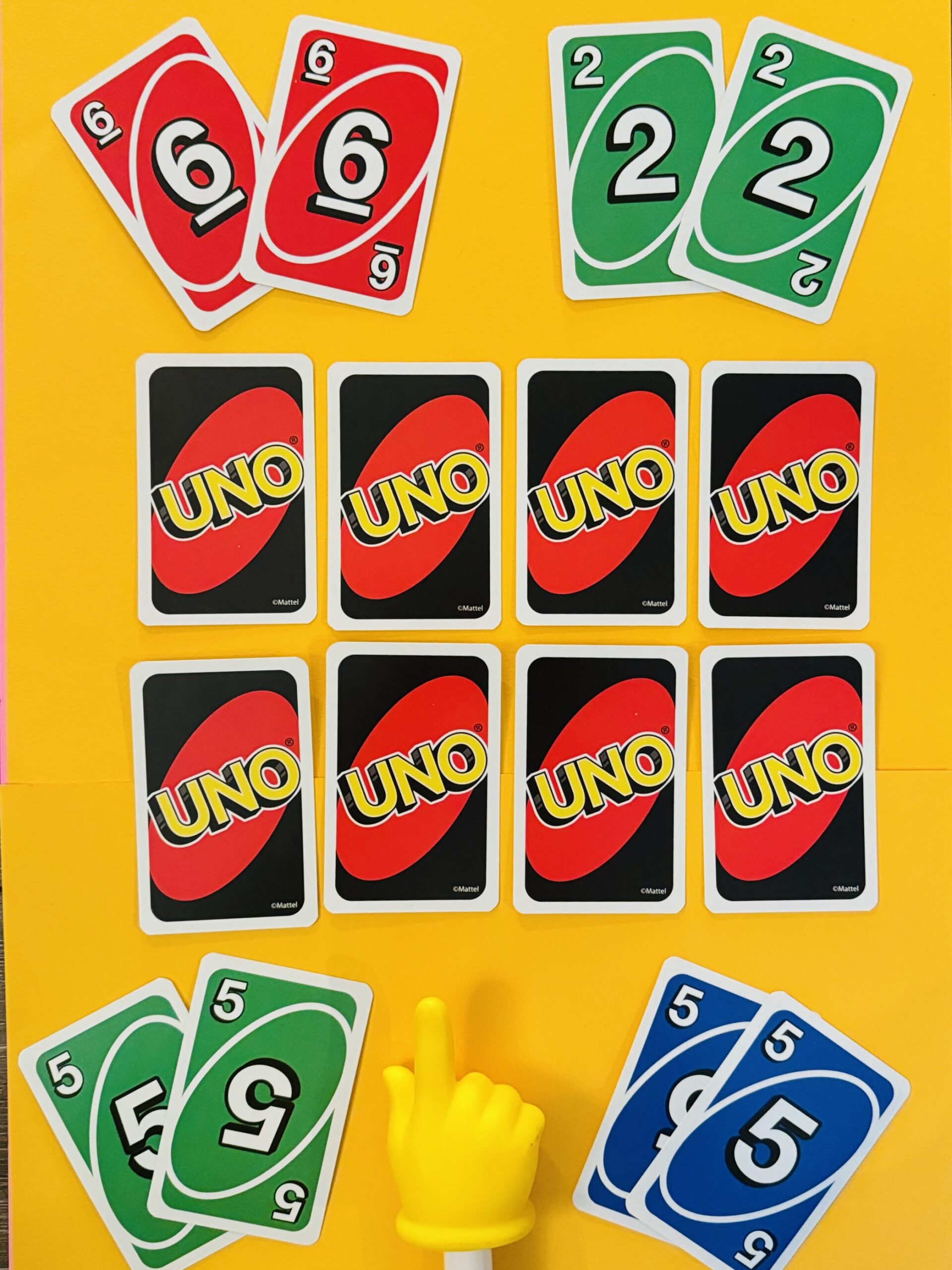
Learning to recognize numbers is a key early math objective. Here’s one of the simple preschool math games to practice that idea. Get a small number of Uno game cards—start with eight and put in matching pairs. Turn the cards face down and let pairs of students take turns flipping over two cards per turn hoping for a match. You can either play so that when they get a match, their turn is over, or when they get a match, they go again.
19. Shape Hunt
Draw the shapes you want your student to practice on separate sheets of card stock. You can also write the shape name. Spread these out on the floor. Have the students hunt in the room for items that are that shape, and put the items on or near that corresponding shape sheet.
20. I Can Hear the Patterns
You can see patterns, you can make patterns, and you can also hear patterns. Using clapping, tapping, and snapping fingers, the teacher/leader sounds out a pattern and the kids follow along and join in. For example, you might do three claps, two taps on the floor, three claps, two taps on the floor. After everyone joins in successfully, stop and ask someone to describe the pattern in words. Extend the patterns when the students seem ready for more complex ones. Then let students take a turn leading.
21. Shape Patterns
Discuss with students how a pattern always repeats. Red, blue is not a pattern until it repeats. On the whiteboard, draw a pattern using shapes. For example, you might draw square, square, square, circle, square, square, circle. Have students come up and draw the continuation of the pattern. Make the patterns more complex when students seem ready for more complex patterns.
This can also be done with colors (of the same shape). For example, draw dots on the board: blue, green, green, red; blue, green, green, red, and have students come up and continue the pattern.
22. Listen and Build Patterns
In this activity, students physically record a listening pattern with blocks. Gather the class in a circle. Explain that you will clap and snap a pattern and that students will make it in front of them using blocks. A blue block is a clap. A red block is a snap. If you make a pattern that is clap, snap, clap, snap, students would put out blue, red, blue, red. Put a pile of blocks in the center. Clap and snap a pattern while the students build it. When done, ask students to explain why they built the pattern they did. Try a few more and then let students take turns leading.
23. Empty Your Cup
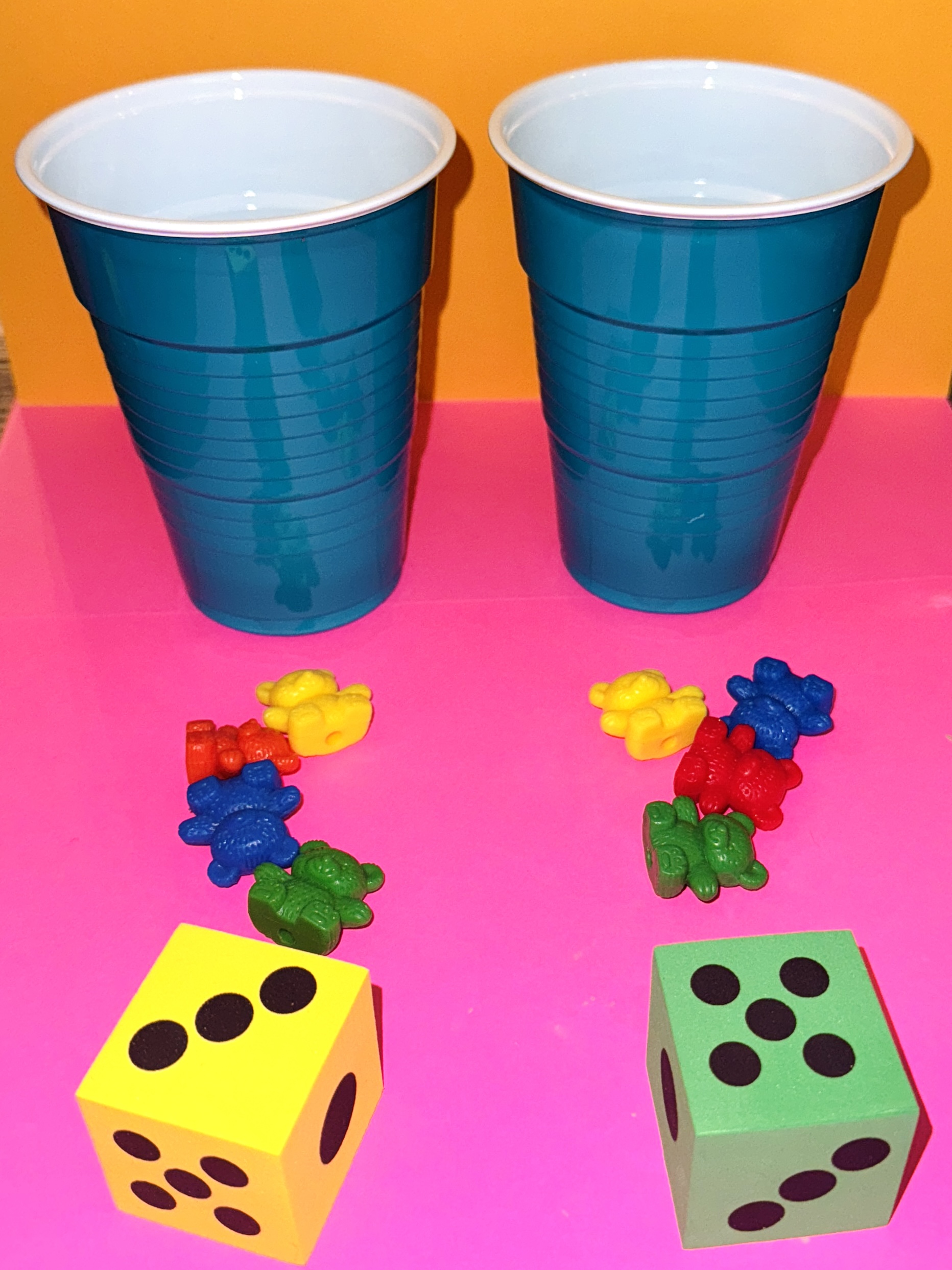
This activity emphasizes counting but also lays the foundation for subtraction. Supplies needed are two same-size plastic cups (large blue or red are perfect), a single die, and the same number of small items (counting bears, building blocks, etc.) that will fit in each cup. Pairs of students take turns rolling the die and removing that many items from their cup. Whoever empties their cup first wins.
24. People Position Patterns
Give each student two sheets of paper. Have them draw two pictures, one of someone standing and one of someone sitting. Urge students to keep the drawings simple. Gather all the sheets and put them in a pile face down. Have a student turn over the top three sheets, and the class will form that pattern. For example, if the pictures show “stand, stand, sit,” students will form a line and the first two students will stand and the third will sit. Students 4 and 5 will stand and student 6 will sit. Continue the pattern with all the students.
25. Picture Frame Patterns
Provide each student with a large sheet of construction paper (the color doesn’t matter) and a glue stick. Put a large number of shapes cut from different colors of construction paper in the center of the table. Ask students to create a pattern around the edge of their sheet of construction paper with two colors or two shapes to form a frame. In the middle of the frame, draw a picture. If you work small, you can make several of these with different frame patterns.
26. Follow That Pattern
Give each student a prepared card or strip of card stock with a pattern on it. The pattern could be of shapes (all the same color) or the pattern could be only colors (all the same shape). Give students a whiteboard or other erasable surface to copy the pattern and continue it.
27. Numeral Writing
Draw a numeral several times on the board. Instruct very specifically exactly how the numeral is drawn. Students use their pointer finger to trace the number in the air, then trace it on their palm, and then on their desks, repeating the teacher’s specific instructions out loud. Then give each student a paper plate with rice, salt, or sand to trace in. Continue to practice. Allow students to take turns “giving the instructions” to the class on how to write the numeral.
28. Follow That Pattern With Blocks
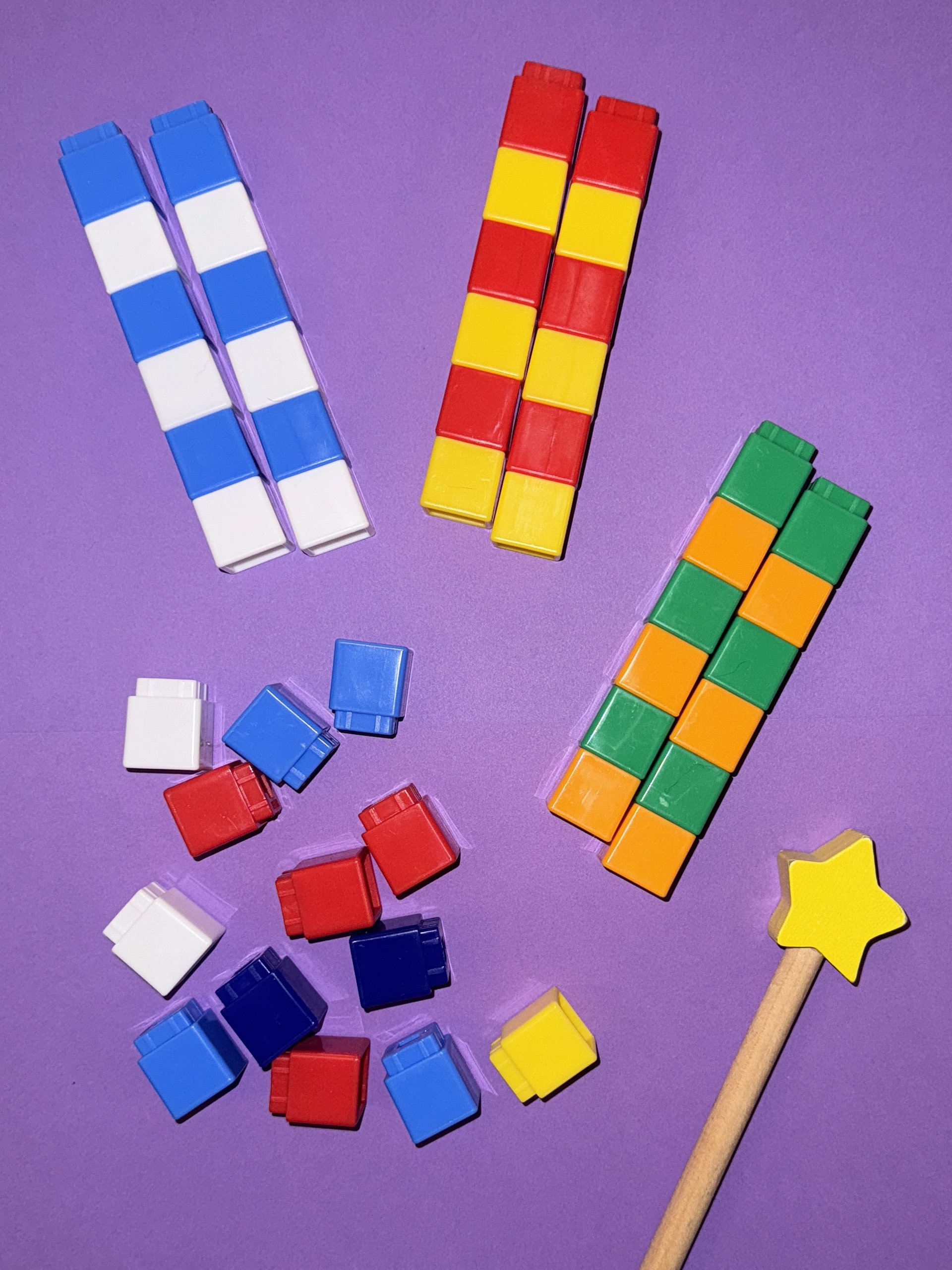
Show the class a pattern you’ve made using different-colored connecting blocks. Give the students blocks and ask them to reproduce that pattern and continue it. Once they’ve shown mastery of this, have students create their own pattern using eight blocks. Collect these and put them in a box. Students take turns pulling these out of the box, bringing them to their seats, and using more blocks to continue the pattern.
29. More Numeral Writing
Pair students up. They’ll need two sets of cards, one with a numeral written on it and the other with a corresponding number of dots. They’ll also need a variety of ways to write the numerals, like chalk and blackboard, markers and whiteboard, salt/sand/rice trays, or shaving cream on the desk. (Students should be given some free exploratory time with the shaving cream. Then the rules and behavior for shaving cream will have to be explained because it is very easy to get distracted by but so motivating!) One student in the pair holds up either a numeral card or a dot card and the other student says the number and writes it the way the teacher has instructed. Students take turns going back and forth as number caller and “recorder.”
30. What’s in the Box? Sort
Give each student a box containing three different types of items like crayons, markers, pencils, sorting bears, Popsicle sticks, or erasers. Tell the students to make three groups, each group having the same type of item. The teacher or a partner checks, then puts the items back in the box and passes the box to the person on their right. Repeat this several times.

